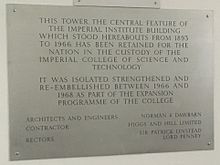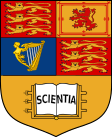Queen's Tower, London





The Queen's Tower is situated in the South Kensington Campus of Imperial College London, England, just to the north of Imperial College Road. It is 87 metres (287ft) tall with a copper-covered dome at its top.[1] To reach the base of the dome from the ground on foot, one must ascend a series of narrow spiral staircases, comprising 325 steps in total. The tower used to be the central tower of the Imperial Institute, and is now the sole remaining part of that building.
History[]
The Imperial Institute was founded on Queen Victoria's Golden Jubilee in 1887, and its partial demolition began in 1957. At that time it was generally known as the Collcutt Tower, after its designer, the Victorian architect Thomas Edward Collcutt. The tower itself would have been demolished along with the rest of the Institute, had it not been for a public campaign led by the then Poet Laureate John Betjeman, a supporter of 19th-century architecture. He warned that tastes in architecture change, and that the destruction of this building (at a time when Victorian architecture had fallen out of favour) would be a loss.[2]
Restoration[]
In 1966, with the rest of the building demolished, the tower was repaired to enable it to stand on its own, which involved the construction of new foundations. There are also two stone lions at the foot of the tower, which were once set at the entrance to the Imperial Institute. These two stone lions are pair of a set of four, the other two (which are not in such good condition) are in the grounds of the Commonwealth Institute.
Bells[]
There are ten bells hung for change ringing in the middle of the tower, about two thirds of the way up. These bells, known collectively as the Alexandra Peal, were a gift from Mrs Elizabeth M. Millar of Melbourne, Australia[3] in 1892, and are named after Queen Victoria — the tenor (largest) bell — the Prince and Princess of Wales (Albert Edward and Alexandra), two other children of Queen Victoria (Alfred and Arthur) and the five Wales grandchildren (Albert Victor, George, Louise, Victoria and Maud). They are rung on royal anniversaries and on the dates of the Imperial College degree ceremonies.
Viewing gallery[]
The highest viewing gallery is below the dome at the top of the building. Upon walking through the door one gets a unique view, with the top of the Albert Memorial on top of the Royal Albert Hall. Being one of the tallest towers in west London, the Queen's Tower enjoys an uninterrupted view in all directions. In fact, it has been estimated that in good viewing conditions the furthest visible point is 20 miles away.[4] As of February 2022, the viewing gallery is closed to visitors.[5]
Imperial College London[]
The Queen's Tower is now in the custody of Imperial College London.
See also[]
References[]
- ^ Christopher Winn (1 March 2018). Walk Through History: Discover Victorian London. Ebury Publishing. pp. 22–. ISBN 978-1-4735-5193-0.
- ^ Expansion of Imperial College: Campaign against demolition Archived 2012-01-18 at the Wayback Machine. Accessed 16 December 2010.
- ^ The Queen’s Tower, Imperial College Statistics and history on the tower and bells. Accessed 16 December 2010
- ^ "Viewing gallery, The Queen's Tower".
- ^ "The Queen's Tower". Imperial College London. Retrieved 2022-02-23.
External links[]
- 1887 establishments in England
- Towers completed in 1887
- Buildings and structures of Imperial College London
- Buildings and structures in the City of Westminster
- Towers in London
- Bell towers in the United Kingdom
- Domes
